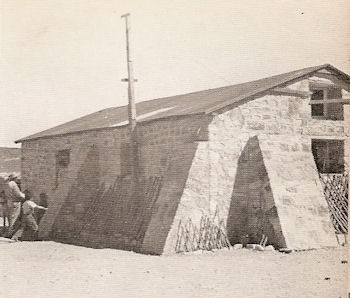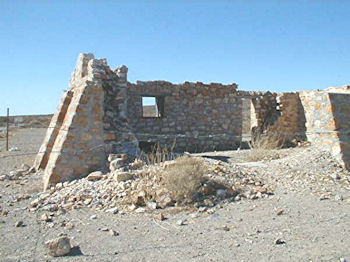 |  |
By Greg Niemann

While El Marmol means “marble” in Spanish, the product from the central Baja quarry of El Marmol is actually the more valuable onyx. At one time this quarry was the world’s largest producer of onyx.
El Marmol is off Highway 1 some 70 miles past El Rosario on a nine-mile dirt road. It’s now a deserted mine where you can marvel at the immense slabs of onyx and the old schoolhouse which was made entirely out of blocks of the creamy stone. Most of the schoolhouse is still standing but inconsiderate people have taken chunks off the building, which is not only unfortunate but unnecessary. All around the area there are many slabs and pieces of the luscious stone there for the picking.
"Lush and creamy" describes the onyx as much of it is milky white; some stones contain streaks of Venetian red or burnt umber, looking like caramel topping mixed with French vanilla ice cream. When cut and polished for ash trays, bookends, paperweights, penholders, knick knacks or figurines, it shines like smooth marble and is an object of beauty.
Making the difficult commonplace
The mining operation at El Marmol was a lesson in determination and making the difficult commonplace, so typical of Baja development.
For millennia the onyx has bubbled out of the ground in this remote section of central Baja, some 300 miles south of Tijuana and about halfway between El Rosario and Punta Prieta. At nearby El Volcan the bubbling carbonated springs still produce the onyx that similarly formed long before at the El Marmol quarry.

Because of the unusual conditions required for its production it is an uncommon stone and for years North Africa was the world’s chief source.
In Baja, the surface around the arid country near El Marmol is mostly mica schists and silicified limestones. After the springs flowed, erosion exposed travertine on the lowest layer and above that, alternating bands of limestone and onyx.
The deposit was discovered in the early 1890s by gold prospectors and the find was announced in scientific journals. That attracted George P. Merrill, head of the Geology Department of the Smithsonian Institute, to visit the site. A piece was polished for display at the then-current Colombian Exposition and that prompted development by an American company.
The company changed hands several times but the American company, Southwest Onyx and Marble Company, had the most success. Early on, large slabs of El Marmol onyx were shipped to grace the lobby of San Diego’s new Spreckels Theater.
The resident managers for the San Diego-based company were first George P. Brown and then his son, Kenneth Brown, both legends of the El Marmol onyx operation. George P. Brown, an engineer, took charge of the operation in 1919 and trained his son to assist. The younger Brown took over in 1934 and was the mine’s driving force for 25 years until it went out of business in 1958.
Even though the nearest drinking water was at Rancho San Augustin eight miles away, a small mining village consisting of crude wooden buildings was constructed. There were some 300 people living there by the late 1920s, and with the exception of the manager all were Mexican workers and their families Water was brought in regularly in a 3,000 gallon truck. Even under these conditions Mrs. Brown, a former society debutante from Kansas City, was able to tend a small flower garden.
The world’s only onyx school

The one-room school was built for the employees’ children and could boast of being the world’s only school to be constructed out of blocks of onyx. In the late 1950’s when visited by the writer O.W. Timberman (Mexico’s Diamond in the Rough), 16 students were being taught by one 18-year-old teacher. I counted 24 students in an earlier photo (1953). When I last visited, the wooden roof was long gone but 3½ of the walls were still standing.
The mined onyx lies in thick layers near the surface. Large slabs were pried loose by six or eight men with pry bars and then lifted to the surface by a huge derrick run by two other men. These huge blocks, some weighing as much as several tons, were then numbered for shipment.
Getting the onyx to port
But getting the onyx out of the mine was not the most onerous task. Getting it to market was another story – Tijuana was a difficult 300 miles away. The Pacific Ocean itself was 48 miles distant and the mining operation established a port at Santa Catarina. I have driven the road to Puerto Santa Catarina some 40 to 50 years later and can only conclude it is very bad and wasn’t any better in the days old Reo and Commando trucks carried the heavy onyx to port. The old trucks even used hard rubber tires that even then had not been in production for years. Visitors to El Marmol during the 1950s noted many hard-tired wheels stockpiled for the arduous rocky journey.
At Santa Catarina the onyx awaited the cargo ships. When one came in, 50 or 60 miners went to load. Flat bottom lighters (like long canoes), just 14 or 15 feet with 8 foot beams were specially designed to carry the onyx to the ship without tipping over. A lighter could carry 10 tons on each trip to the ship anchored approximately a quarter mile offshore. Optimum tides and calm seas were required to get the job done. Because of big waves and rough seas, some days only six to 12 tons could be loaded while other days they could load from 50 to 100 tons. It usually took about 12 days to load a ship with the ship’s booms lowering the cargo into the holds.

Previous to El Marmol it had been onyx from Algerian quarries that had added many luxurious touches to Europe’s cathedrals, churches and public buildings, including the grand staircase of the Paris Opera House.
During the heyday of El Marmol, Baja onyx found its way around the world, to markets in England, Belgium, the Orient, and the U.S., most of it used for mantel pieces, table tops, and smaller ornamental objects. Mr. Brown even supervised the cutting, loading and hauling of a statue for the St. Paul, Minnesota Courthouse that weighed over 120,000 pounds. It was 85 feet tall and 21 feet wide.
There was one moment of glory for El Marmol onyx as legend has it that that “Vamp Girl” Theda Bara ordered one huge block to have her bathtub carved out of it. According to an old press release, the smooth-stoned onyx bathtub would be accompanied by gold faucets, naturally.
The quality of onyx taken out of Baja’s remote outback was considered the finest anywhere. However, due to the post-World War II advent of plastics and other inexpensive materials, demand for the pricey onyx dropped. The mine closed down in 1959 and Mr. Brown went to live in San Diego.
Behind where Highway 1 passes the Rancho San Augustin there is a dirt road to El Marmol. I often take the time to drive the 18 mile round-trip dirt road and look around or add a few new pieces to my gardens. Mostly, I just like to be there to feel another part of the remarkable part of Baja’s history coursing through my veins.

About Greg
Greg Niemann, a long-time Baja writer, is the author of Baja Fever, Baja Legends, Palm Springs Legends, Las Vegas Legends, and Big Brown: The Untold Story of UPS. Visit Greg's website.

You cannot beat the convenience and price. We drive vehicles into Mexico all year. Some stay for...

Very easy process to purchase online. Very reasonable rates. Lots of good insight and helpful...

I would like to personally thank Michelle Lopez for her assistance on getting our insurance...